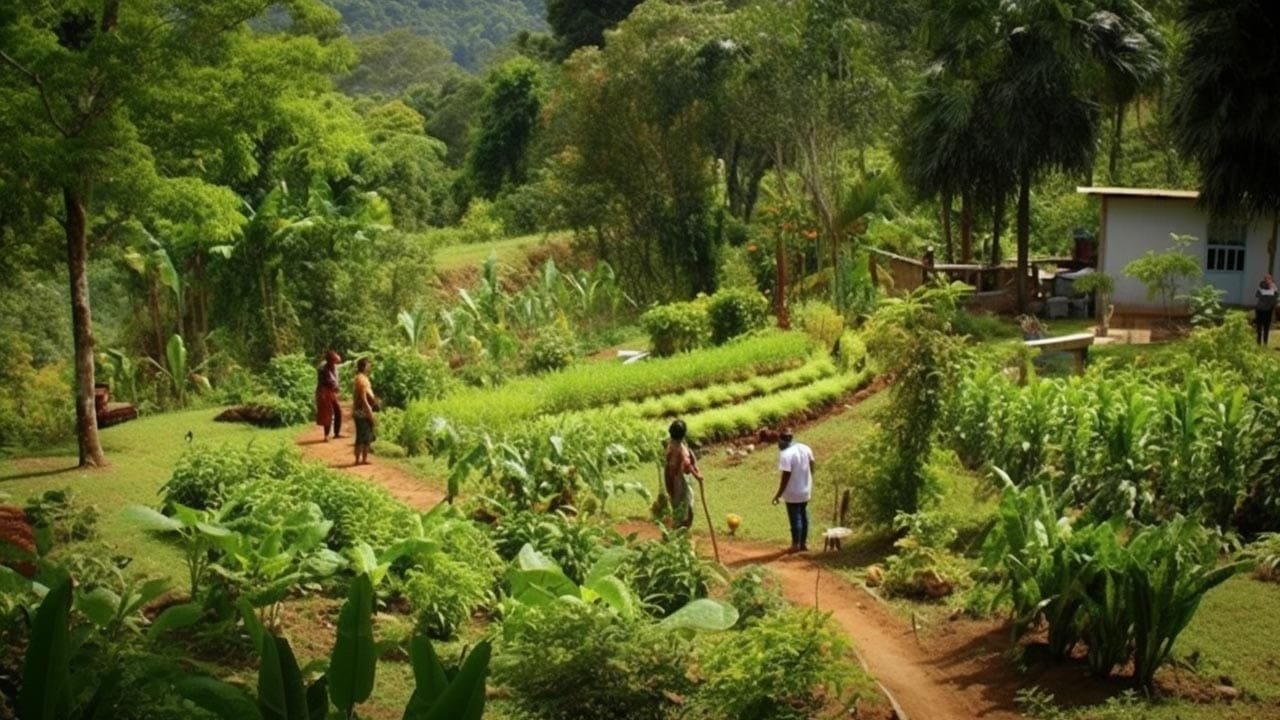Syntropic agroforestry is an innovative approach to farming that combines principles of ecology, succession, and traditional agriculture to create regenerative and productive ecosystems. This method is gaining traction globally due to its potential to address some of the most pressing environmental challenges of our time, including deforestation, soil degradation, and biodiversity loss. In this comprehensive article, readers will delve deep into the world of syntropic agroforestry, understanding its principles, benefits, and real-world applications. By the end of this piece, you will have a clear grasp of why this method is considered a game-changer in sustainable agriculture and how it can pave the way for a more resilient and ecologically balanced future.
Let’s dig in, What is Syntropic Agroforestry?
Table of Contents
- Principles of Syntropic Agroforestry
- Benefits of Syntropic Agroforestry
- Real-world Applications
- Frequently Asked Questions
- Final Thoughts
- Sources
Principles of Syntropic Agroforestry
Syntropic agroforestry is a holistic approach to agriculture that seeks to create a harmonious relationship between various plant species, the environment, and human intervention. This method is rooted in understanding and mimicking the natural processes of forest ecosystems. Here’s a deeper dive into its core principles:
1. Successional Agroforestry Systems (SAFs)
Succession in nature refers to the process by which plant communities evolve over time. In syntropic agroforestry, this concept is applied to farming by:
- Stages of Succession: Different stages of plant succession, from pioneering species to climax species, are integrated. Pioneering species, which are typically fast-growing, prepare the soil for subsequent species.
- Continuous Productivity: As one species completes its life cycle, another is ready to take its place, ensuring that the land remains productive throughout the year.
2. Biodiversity
A cornerstone of syntropic agroforestry is the emphasis on biodiversity:
- Interplanting: Multiple species are planted together in close proximity, allowing them to interact and support each other.
- Resilience: A diverse ecosystem is less susceptible to pests and diseases, reducing the need for chemical interventions.
- Ecological Balance: The presence of various species ensures a balance of predators and prey, further reducing pest issues.
3. Stratification
Mimicking the layers of a natural forest, syntropic systems utilize vertical space:
- Multiple Canopies: Different plants grow at varying heights, from ground-cover species to tall trees. This stratification allows for optimal sunlight utilization and protection from harsh weather conditions.
- Niche Specialization: Each plant species occupies a specific niche, reducing competition and promoting symbiotic relationships.
4. Natural Pruning and Mulching
This principle focuses on recycling organic matter:
- Pruning: Regularly cutting back certain plants stimulates growth and provides fresh organic material. This pruned matter is left on the ground.
- Mulching: The organic material decomposes, acting as a mulch. This mulch retains moisture, suppresses weeds, and slowly releases nutrients back into the soil.
5. Soil Health and Regeneration
Healthy soil is the foundation of any agricultural system:
- Organic Matter: Continuous addition of organic material improves soil structure, making it more porous and aerated.
- Microbial Life: The organic matter feeds soil microbes, which in turn benefit plants by breaking down nutrients and improving soil health.
- No-Till: Syntropic systems often avoid tilling the soil, preserving its structure and microbial communities.
6. Water Management
Efficient water use is integral to syntropic agroforestry:
- Natural Irrigation: The design of the land, often using contour lines, captures and retains rainwater, reducing the need for artificial irrigation.
- Root Systems: Different plants have varying root depths, allowing for efficient water absorption and reducing runoff.
Syntropic agroforestry is a symphony of interactions, where each element, be it a plant species or a farming practice, plays a crucial role in creating a resilient, productive, and sustainable system.
Benefits of Syntropic Agroforestry
Syntropic agroforestry, with its roots in ecological harmony and sustainable practices, offers a plethora of benefits that address both environmental and socio-economic challenges. Here’s an in-depth exploration of the myriad advantages of this innovative approach:
1. Soil Regeneration and Health
- Organic Matter Enrichment: The continuous cycle of pruning and mulching in syntropic systems ensures that the soil is consistently replenished with organic matter. This enhances soil fertility, structure, and water retention capabilities.
- Microbial Flourishing: The addition of organic matter fosters a rich microbial environment. These microorganisms play a pivotal role in nutrient cycling, ensuring plants have access to essential minerals and nutrients.
- Erosion Control: The multi-layered canopy and ground cover plants help bind the soil, reducing erosion caused by wind and water.
2. Carbon Sequestration and Climate Change Mitigation
- Carbon Storage: Trees and other vegetation act as carbon sinks, absorbing carbon dioxide from the atmosphere and storing it in their biomass and the soil. This process is vital in the fight against global warming.
- Reduced Greenhouse Gas Emissions: By minimizing or eliminating the use of synthetic fertilizers and pesticides, syntropic systems produce fewer greenhouse gas emissions compared to conventional farming.
3. Biodiversity Conservation and Enhancement
- Habitat Creation: The diverse ecosystems created in syntropic farms provide habitats for a wide range of fauna, from insects to larger animals.
- Genetic Diversity: Growing a variety of plant species ensures genetic diversity, which is crucial for resilience against diseases and changing climate conditions.
4. Water Conservation and Quality
- Efficient Water Use: The organic matter in the soil improves its water retention capacity, reducing the need for frequent irrigation.
- Water Quality: By avoiding or minimizing the use of chemicals, syntropic systems prevent the contamination of groundwater, preserving the quality of water sources.
5. Economic and Social Benefits
- Diversified Income Streams: Farmers practicing syntropic agroforestry can harvest multiple crops throughout the year, ensuring a steady and diversified income.
- Job Creation: The diverse and intensive nature of syntropic systems often requires more labor, leading to job creation in rural areas.
- Community Resilience: Syntropic farms can act as community hubs, fostering knowledge exchange, collaboration, and strengthening community bonds.
6. Reduced Dependency on External Inputs
- Natural Pest and Disease Control: The biodiversity in syntropic systems creates a balance of predator-prey relationships, reducing the need for chemical pesticides.
- Natural Fertility: The continuous return of organic matter to the soil, coupled with the presence of nitrogen-fixing plants, reduces the dependency on synthetic fertilizers.
7. Resilience to Environmental Stresses
- Climate Resilience: Diverse ecosystems are better equipped to handle extreme weather events, be it droughts, floods, or storms.
- Pest and Disease Resilience: A diverse plant community reduces the risk of large-scale infestations or disease outbreaks.
Syntropic agroforestry presents a holistic solution to many of the challenges faced by modern agriculture. It offers a path that not only ensures productivity but also champions the principles of sustainability, resilience, and ecological balance.
Real-world Applications
Syntropic agroforestry, while rooted in age-old agricultural practices, has found renewed interest in recent years due to its sustainable and regenerative approach. Across the globe, farmers, researchers, and environmentalists are adopting and adapting these methods to suit local conditions, challenges, and needs. Here’s a closer look at some of the real-world applications of syntropic agroforestry:
1. Brazil: Transforming Degraded Lands
- Ernst Götsch’s Legacy: Often considered the pioneer of modern syntropic agroforestry, Swiss farmer Ernst Götsch has transformed large tracts of degraded lands in Brazil into lush, productive forests using syntropic methods. His farm has become a model for many, demonstrating the potential of this approach.
- Reforestation Projects: Many regions in Brazil, especially those affected by deforestation, are now witnessing reforestation efforts using syntropic principles. These projects aim to restore biodiversity, improve soil health, and provide livelihoods to local communities.
2. Australia: Combating Soil Erosion and Desertification
- Farm Adaptations: In regions facing soil erosion and desertification, Australian farmers are turning to syntropic agroforestry. By establishing multi-layered plant systems, they are enhancing soil structure, reducing erosion, and increasing water retention.
- Community Initiatives: Several community-driven projects in Australia focus on educating farmers about the benefits of syntropic farming, providing them with the tools and knowledge to transition from conventional methods.
3. Africa: Restoring Desertified Lands and Boosting Livelihoods
- Desert Greening: In parts of Africa, where desertification is a pressing issue, syntropic methods are being employed to green the desert. By introducing hardy pioneer species that can thrive in arid conditions, these projects lay the groundwork for more diverse plant communities in the future.
- Community Empowerment: Syntropic agroforestry projects in Africa often have a strong community focus. They aim to provide local communities with sustainable livelihoods, food security, and resilience against climate change.
4. Southeast Asia: Enhancing Biodiversity in Monoculture Regions
- Breaking Monocultures: In areas dominated by monocultures, like palm oil plantations, there’s a growing movement to integrate syntropic principles. By introducing a variety of plant species, these regions are slowly transforming into more diverse and resilient ecosystems.
- Agro-Tourism: Some farms in Southeast Asia are combining syntropic agroforestry with tourism. Visitors get a chance to learn about these sustainable farming practices, while farmers diversify their income sources.
5. Europe: Modern Farms Embracing Ancient Wisdom
- Educational Farms: Several farms in Europe, especially in countries like Spain, Portugal, and France, are adopting syntropic methods and serving as educational hubs. They offer workshops, courses, and hands-on experiences for those interested in learning about this approach.
- Urban Initiatives: In some European cities, urban farming initiatives are incorporating syntropic principles. These projects aim to bring sustainable agriculture to urban settings, promoting local food production and biodiversity.
Real-world applications of syntropic agroforestry are as diverse as the ecosystems it seeks to emulate. From large-scale reforestation projects to small community farms, this approach is proving that agriculture can coexist harmoniously with nature, providing both ecological and economic benefits.
Frequently Asked Questions
Final Thoughts
Syntropic agroforestry is not just a farming method; it’s a philosophy that emphasizes harmony with nature. The most significant takeaway is its potential to revolutionize how we view agriculture. Instead of depleting resources, farming can regenerate and restore. By mimicking nature, we can create systems that are not only productive but also sustainable in the long run.
Sources
- Agroforestry World – ICRAF
- Ernst Götsch’s work in Brazil
- The Syntropic Agriculture Movement
- Syntropic Farming: An Introduction






Leave A Comment